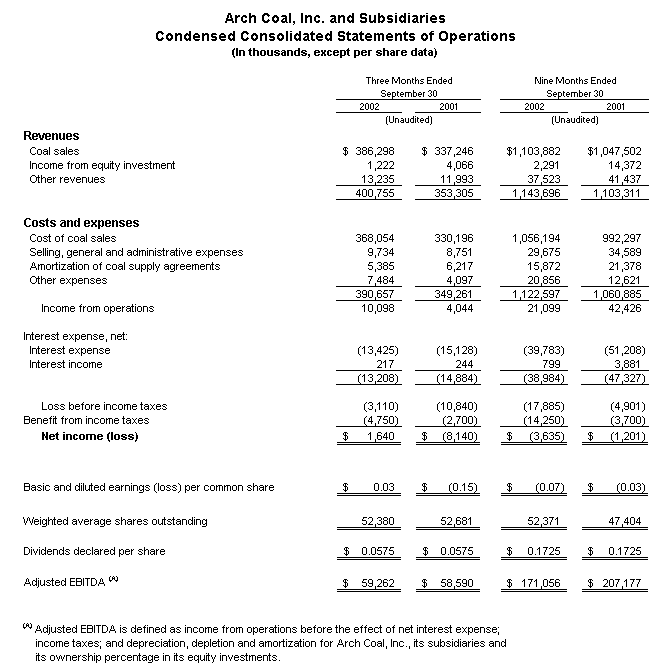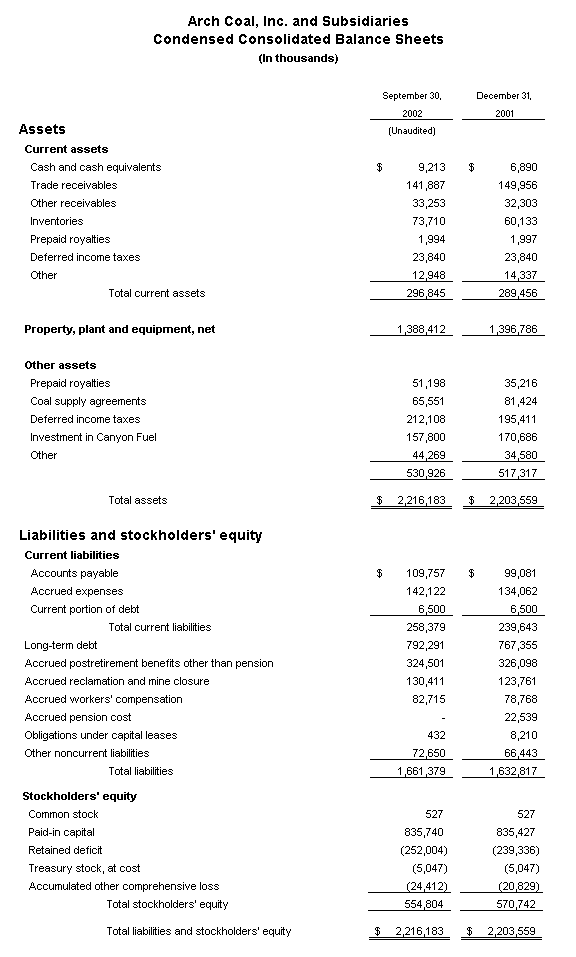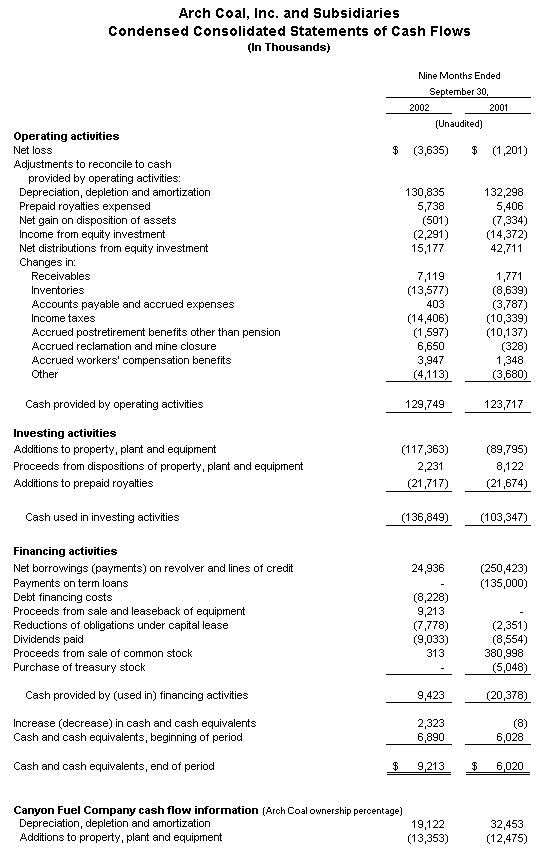Arch Coal, Inc. Reports Third Quarter Results
Arch Coal, Inc. Reports Third Quarter Results
October 21, 2002 at 10:30 AM EDT
Highlights:
- Net income of $1.6 million, or $.03 per share, vs. a net loss of $8.1 million, or $.15 per share, in 3Q01
- Adjusted EBITDA of $59.3 million, vs. $58.6 million in 3Q01
- Total revenues of $400.8 million, vs. $353.3 million in 3Q01
- Coal sales of 28.7 million tons, vs. 27.1 million tons in 3Q01
“While we are seeing signs that the fundamentals for U.S. coal markets are improving, coal demand and pricing remained depressed during the third quarter,” said Steven F. Leer, Arch Coal’s president and chief executive officer. “As a result, Arch continued to curtail production at several key operations while maintaining its focus on cost controls. Meanwhile, solid performances at most of our mines – including a strong performance at Black Thunder and substantially improved results at Samples – had a positive impact on our quarterly results.”
Black Thunder’s sales volume increased substantially, as the mine reduced inventory and began to ship some of the contract sales volumes that had been deferred by customers earlier in the year. Having advanced through an area of difficult geology into a new reserve area earlier in the year, the Samples mine in southern West Virginia achieved higher volumes and lower costs in the third quarter.
Sales volumes also increased due to higher production levels at the West Elk mine in Colorado, which had been curtailed by high methane levels last year, and higher brokered volumes in the east. Overall, sales volumes increased by 1.6 million tons, while production was roughly 1.1 million tons lower than in the same quarter of last year.
During the first nine months, the company benefited from lower net interest expense, the result of last year’s aggressive debt reduction program and a lower average interest rate on its floating rate debt. Net interest expense was 18% lower for the first nine months of the year, and 11% lower for the quarter.
U.S. Coal markets
Beginning in the second half of 2001, very weak economic activity and mild winter weather dampened coal demand and pricing, while acting to drive utility stockpiles to abnormally high levels. Despite a hot summer that reduced those stockpiles markedly, many power generators have remained on the sidelines during the initial stages of the traditional contract buying season.
“We are taking a very patient approach to this market,” Leer said. “While we can’t say exactly when coal markets will turn, current trends suggest that a correction may be near.”
The principal question appears to be one of timing, according to Leer. “Nationwide, coal production is down more than 3% year to date, according to the U.S. Energy Information Administration, while electricity demand appears to be climbing once again,” he said. “If those trends continue, the market is almost certain to tighten.”
Nearly all of the production cuts have come in the eastern United States, where producers continue to face a range of challenges, including difficulties in obtaining new mining permits, limited access to capital, lack of surety bonding capacity, higher insurance premiums, and ongoing degradation of the highest quality reserves in the region.
“These challenges have led to the rationalization of supply in the east,” Leer said. “Some of the high-cost production that has exited the marketplace is unlikely to return even in an improving price environment. In fact, many of the weaker and more capital-constrained producers will find it difficult to maintain production even at current levels.”
Production in Central Appalachia, the nation’s second largest coal-producing basin, is likely to decline by as much as 15 million tons this year, and further reductions appear likely in the future, Leer said.
Another positive impetus for improving market conditions is the high price of natural gas. The near-month futures contract for gas is currently trading at levels well above $4 per million Btu’s, which means that coal-fired power plants will dispatch electricity to the grid before gas-fired power plants in nearly every instance.
Arch’s estimates suggest that stockpile levels at the end of September were very much in line with levels at the same point in the year during 1999, 2000 and 2001. “It is possible – and entirely understandable, given today’s difficult power markets – that power producers are planning to operate with stockpiles at levels lower than the historical range,” Leer said. “If that is the case, the long run impact is likely to be a positive one for coal producers, as the market moves towards better overall supply-demand balance.”
Other developments
In September, Arch’s 65%-owned Canyon Fuel Company completed the installation of a new longwall mining system at Dugout Canyon that is expected to increase annual production levels at the mine by approximately 2.5 million tons, to approximately 4 million tons per year. The project had been delayed until planned volume additions could be fully contracted.
“Given the insulated nature of the Utah marketplace and reserve depletion at several competitor operations, we believe the Dugout expansion is a wise and market-driven use of capital,” Leer said.
Arch continues to be extremely judicious about capital spending. For the first nine months, capital expenditures (including 65% of Canyon Fuel’s capital spending) totaled just over $130 million. The company currently expects capital expenditures of around $160 million for the full year.
Natural Resource Partners
In October, Arch completed the sale of 1.9 million units of Natural Resource Partners (NYSE:NRP), a newly formed joint venture created to manage coal royalty properties. Net proceeds to Arch, after the underwriting discount and expenses, totaled $33.6 million. The proceeds were immediately applied to debt reduction.
“We believe that the formation of Natural Resource Partners and our initial sale of NRP units represent a very effective way to create value for Arch’s shareholders,” Leer said. “We have long believed that our coal reserves that were owned in fee were undervalued on our balance sheet. The formation of NRP created a vehicle that has allowed us to monetize the value of a portion of these assets for debt reduction purposes, while establishing a market value for the remainder.”
The formation is expected to be accretive to earnings, beginning immediately. With the sale now completed, Arch holds 34.1% of the NRP units and 42.25% of the general partnership.
Operating statistics
Regional analysis: Of the 28.7 million tons of coal that Arch sold during the third quarter, approximately 8.3 million tons originated at its eastern operations and 20.4 million tons originated at its western operations. Arch Coal had an average realized sales price of $13.45 per ton and average operating costs of $12.82 per ton. The eastern operations had an average realized sales price of $30.08 per ton and an average cost of $28.86 per ton during the quarter. The western operations had an average realized sales price of $6.63 per ton and an average cost of $6.23 per ton during the quarter. (Western operations data does not include the results of 65%-owned Canyon Fuel Company, which is accounted for on the equity method.)
Expected sales volume for the fourth quarter of 2002: In the east, Arch expects to sell a total of approximately 6.8 million tons of coal in the fourth quarter of 2002 from its mines in Central Appalachia, excluding brokered tons. In the west, Arch expects to sell approximately 17.0 million tons of coal at its Black Thunder mine in the Powder River Basin of Wyoming, and roughly 1.8 million tons at the West Elk mine in Colorado, excluding brokered tons. Total sales (on a 100% basis) at Arch’s 65%-owned Canyon Fuel operations in Utah are expected to be approximately 3.4 million tons for the quarter.
Financial: Arch expects depreciation, depletion and amortization to total approximately $205 million for the full year. Capital expenditures are expected to total around $160 million. (Projections for depreciation, depletion and amortization and capital expenditures include Arch’s ownership percentage in Canyon Fuel Company.)
Looking ahead
At present, 15% to 20% of Arch’s planned 2003 production and 50% of its planned 2004 production is uncommitted or unpriced. “We are very comfortable with our open position,” Leer said. “We continue to believe that the downside for U.S. coal pricing is limited, and that the upside is significant. We are simply unwilling to sign commitments at prices that will not provide a reasonable return to our shareholders.”
At the same time, Arch will continue to produce at reduced levels until the market strengthens. “We will bring back volumes when the market needs the coal, and not before,” Leer said. As a result, Arch expects earnings in the fourth quarter to be around breakeven levels.
“We continue to believe that the intermediate and long-term prospects for the strongest players in the U.S. coal sector are bright, and we remain focused on taking the steps necessary to deliver superior returns to our shareholders,” Leer said.
Definition: Adjusted EBITDA is presented above because it is a widely accepted financial indicator of a company’s ability to incur and service debt. Adjusted EBITDA should not be considered in isolation or as an alternative to net income, operating income, cash flows from operations, or as a measure of a company’s profitability, liquidity or performance under generally accepted accounting principles. Adjusted EBITDA is defined as income from operations before the effect of net interest expense, income taxes, and depreciation, depletion and amortization for Arch Coal, Inc., its subsidiaries and its ownership percentage in its equity investments.
Forward-Looking Statements: Statements in this press release which are not statements of historical fact are forward-looking statements within the “safe harbor” provision of the Private Securities Litigation Reform Act of 1995. These forward-looking statements are based on information currently available to, and expectations and assumptions deemed reasonable by, the company. Because these forward-looking statements are subject to various risks and uncertainties, actual results may differ materially from those projected in the statements. These expectations, assumptions and uncertainties include: the company’s expectation of continued growth in the demand for electricity; belief that legislation and regulations relating to the Clean Air Act and the relatively higher costs of competing fuels will increase demand for its compliance and low-sulfur coal; expectation of continued improved market conditions for the price of coal; expectation that the company will continue to have adequate liquidity from its cash flow from operations, together with available borrowings under its credit facilities, to finance the company’s working capital needs; a variety of operational, geologic, permitting, labor and weather related factors; and the other risks and uncertainties which are described from time to time in the company’s reports filed with the Securities and Exchange Commission.


